
24 minute read
Western Cape Overview Western Cape, a hub for economic growth
Western Cape: a hub for economic growth
When people think of the Western Cape, they immediately think of Cape Town – the Mother City. But the province has so much more to offer. At the end of 2019, Wesgro, the official tourism, trade and investment promotion agency for Cape Town and the Western Cape, launched its first research report into the area. Thanks largely to the information contained in that report, we have compiled the following highlights in an overview of the region
Advertisement
Extracts from Wesgro: The Western Cape Property Report 2018/19 For the full range of research and documentation produced by Wesgro, and for more information about the organisation, visit wesgro.co.za
First, our thanks must go to Tim Harris, Chief Executive Officer at Wesgro, for giving us the green light us to republish elements of the report. Second, at the launch of the report, prominent Mayco members expressed their backing for the drive to promote Cape Town and the Western Cape as a region where things get done – a region to invest in.
“It is in everyone’s interest that we successfully promote the city and the whole region as a competitive business and leisure destination globally,” said Harris. “We do this by attracting and retaining foreign direct investment, landing film and media productions, growing exports, and ensuring more business and leisure tourists visit our province. We do this by facilitating important dialogue between the private and public sector in our region and beyond.”
“We also look to align the Western Cape with national priorities in terms of economic growth, trade and investment promotion initiatives, and facilitate the links between business and government decision-makers. To this end, we are often the first port of call for foreign buyers, local exporters and all investors looking towards the ever-growing potential of our region.”
“The growth of the Western Cape economy and the F
WESGRO 2018/19 THE WESTERN CAPE PROPERTY REPORT
all-important creation of more jobs is the engine that drives the work of the Western Cape Government,” added David Maynier, the MEC for Finance and Economic Opportunities in the Western Cape. “But that engine requires a physical space; a place to set up shop and to provide offices and factory space; a space on which to build homes for its employees. This physical space is property, and it is often the foundation, quite literally, on which investment is built.”
“To help current and future investors make key decisions around the various markets and sectors in our region, we first need to fully understand the research and data on the region,” said Harris. “We believe these markets and sectors have a common denominator in the value of property – the fixed capital asset that the lion’s share of investors will require to make their investment visions a reality, whether that asset falls into commercial, retail, industrial or residential property. “Wesgro believes that property is a key driver of investment in any region, and often the first

consideration investors will make when deciding on their locale. Just as it is true for property across the globe, location really does count, and the Western Cape offers some of the best locations in the world.”
The report suggests it’s a “buyer’s market”, and while the phrase is most commonly used to describe a point in time in a residential property cycle, the general consensus is that the Western Cape is a buyer’s market across all its property nodes, making it attractive to those looking to make fixed capital investments for the first time, as well as to those looking to expand on their existing investments.
After many years of high property price growth, due in no small part to the desirability of the Western Cape and strong semi-gration trends from other parts of the country, property values are stabilising throughout the province, but particularly in and around Cape Town. These are offering opportunities that will no doubt continue to appreciate in value above any others in the rest of the country, albeit it at a more reasonable rate than experienced over the past decade. Cape Town: making progress possible Cape Town has a diverse economy with several flourishing sectors. It is South Africa’s second-largest economic centre and second-most-populated city after Johannesburg. It is also home to one of the busiest container ports in the country, as well as the second busiest airport. Furthermore, it is the second-most important contributor to national employment and plays a crucial role in job creation in South Africa. The strategic sectors positioned for growth include manufacturing, financial services, agri-business, tourism, film and media, digi-tech and business process outsourcing. Within these, particular nodes of growth include real estate, property development and construction, as well as dynamic enterprises involved in boat building, clothing and textiles, electronics, renewable energy and growing the green economy.
Cape Town experienced an unprecedented drought in 2017 and 2018, with severe water restrictions imposed at the time. This resulted in the city establishing its Water Resilience Strategy, which not only turned Cape Town away from the brink of disaster, but also put measures in place for the short, medium and long term to prevent the situation arising again, thus strengthening its overall resilience. Spotlight on economic sectors The six largest economic sectors in Cape Town by value in 2018 were finance, insurance, real estate and business services (contributing an estimated R115.69-billion or 27.33% of gross value added, or GVA); wholesale and retail trade catering and accommodation (R72.39-billion or 17.1% of GVA); manufacturing (R63.34-billion or 14.96% of GVA); general government (R52.93-billion or 12.5% of GVA); transport, storage and communication (R48.24-billion or 11.4% of GVA); and community, social and personal services (R28.88- billion or 6.82% of GVA). “To help current and future investors make key decisions around the various markets and sectors in our region, we first need to fully understand the research and data on the region”
With Cape Town emerging as a key financial services hub in South Africa, a large portion of private investment and asset management services as well as insurance companies are located here, including the head offices of Old Mutual Africa, Santam, Direct Axis, Metropolitan and Sanlam.
In terms of the business services sector, business process outsourcing (BPO) and information technology were the largest contributors to employment growth in Cape Town between 2006 and 2016. A research report released in 2018, commissioned by the Cape Innovation and Technology Initiative (CiTi), Wesgro and the Allan Gray Orbis Foundation, found that more than 40 000 people are now employed in the Cape Town tech industry – twice as many as in Johannesburg.
Cape Town has indeed emerged as a significant technology and innovation hub, with the largest telecommunications market and the most venture capital activity in South Africa, according to Invest Cape Town.
Other economic sectors that play an important role are construction (R21.99- billion); food, beverages and tobacco (R18.52- billion); electricity, gas and water (R12.89- billion); petroleum products, chemicals, rubber and plastic (R12.34-billion); and communication (R43-million).
Of particular interest in terms of the latter is that Cape Town is also South Africa’s “new media” hub, with 57% of all South African gaming studios located in the city, as well as a large proportion of the country’s animation studios.
Cape Town’s boat-building economy is also proving its worth, with more than R1-billion in export revenue now generated annually, according to the office of the Mayor. Key factors in Cape Town’s attractiveness The City of Cape Town is involved in a number of initiatives aimed at attracting investors through the expansion of infrastructure and easing the path towards doing business. Cape Town International
Airport expansion
Cape Town International Airport is set to undergo extensive upgrades and expansions to the tune of R7-billion over the next four years. Construction, which is expected to commence in early 2020, is set to be completed by 2023. The planned upgrades and expansions include the building of a new runway, as well as new international and domestic departure lounges to meet the ever-growing demand on the facility. In parallel, new flights are continuously being added, thanks to the phenomenal success of the Cape Town Air Access (CTAA) initiative – a powerful collaboration and combined effort between the City of Cape Town, the Western Cape government, Airports Company South Africa, Cape Town Tourism, Wesgro, South African Tourism and the private sector. The primary mandate of the Air Access team is to promote, develop and maintain air routes in and out of Cape Town International Airport through route retention (ensuring the success of existing routes); route expansion (increasing frequency and capacity on existing routes); and new route establishment (facilitating the establishment of new routes).
Since inception in 2015, the initiative has launched 15 new routes and facilitated 21 route expansions. This has doubled seat capacity at Cape Town International Airport, adding 1.5-million two-way seats to the Cape Town network, and contributing an estimated R6-billion in direct tourism spend since July 2015. Since inception in 2015, the Cape Town Air Access initiative has launched 15 new air routes in and out of Cape Town, and facilitated 21 route expansions

Streamlining business InvestSA is a one-stop shop based in the heart of the Cape Town CBD at the Cape Investor Centre, which was launched in 2018. Operated by Wesgro and the Western Cape government, it is a multifaceted collaboration between national, provincial and local government to cut the “red tape” for investors wishing to set up or expand their business interests in South
Africa. This initiative clusters key government departments and agencies under one roof to provide investors with a single point of service with regards to aspects such as regulatory compliance, enhancing regulatory and legal processes and improving approval turnaround timeframes. It also provides information on incentives (such as tax, land, training and free-trade zones) as well as on both preapprovals (market data, costs, incentives, project approval and local partners) and post-approvals (facilitation of permit approvals, information relating to importing of equipment and raw materials, and central bank profit repatriation to investors). This collaboration follows the launch by the city of the targeted Invest Cape Town initiative in 2017.
Creating a smart city through the City of Cape Town Broadband Project The objective of the city’s Broadband Project is to create a high-speed, high-capacity municipal telecommunications network – the Metro Area Network (MAN) – which will extend throughout the greater Cape Town area. This is designed primarily to meet the needs of the city, as well as to provide services to both the general public and the private sector. A Telecoms Networks Strategy positions the MAN as the carrier for a number of networks and services. As of June 2018, core network construction had already installed 750km of fibre-optic cabling within the metro and, by completion of the project (scheduled for June 2021), 1 317km will have been installed. Of the 95 switching facilities that will ultimately be in service, 31 are already operational. The network will connect 736 city buildings and approximately 300 private buildings. Since its 2009 inception, the capital spend on the Broadband Project sits at R1.3-billion (as at June 2018), with a remaining R805-million still to be spent.
According to Invest Cape Town, 848km of fibre-optic cable have been installed thus far in greater Cape Town (with 1 827km planned). A total of 475 buildings have been connected via the MAN, while free Wi-Fi has been installed at 715 access points at 225 locations.
Positioning Cape Town as the green economy hub of South Africa As the Western Cape has positioned itself as the green economy hub of South Africa, this is of particular importance and relevance to the City of Cape Town. Several renewable energy companies have already made Cape Town their home across the spectrum of solar photovoltaic manufacturing, electrical manufacturing, fuel supply, professional services and supporting bodies.
Cape Town’s three universities also actively contribute towards research and development in the field of renewable
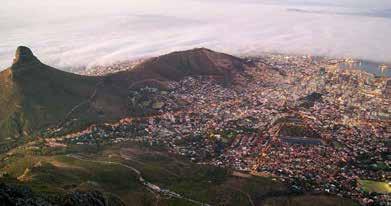
energy. In turn, the City of Cape Town has established the Atlantis Greentech Special Economic Zone (SEZ), making tracts of land available at low cost for purchase or lease by green-tech companies through an accelerated land disposal process. A number of other financial and nonfinancial incentives are also available, which include discounted electricity rates and rapid turnaround on development applications.
Reasons to invest: Cape Winelands
Working towards an enabling business environment The municipalities in this district are all similarly aligned in their business processes. While land rezoning is still timeconsuming, local business chambers have commented positively on building plan approval turnarounds, particularly where electronic systems are in place. In terms of Drakenstein (into which Paarl falls), business licences take an average of 20 to 25 days and building plan approvals take 21 days – but rezoning can take between eight and 12 months. Stellenbosch (into which Franschhoek falls) reports that approvals for business licences take one day, building plans 30 days and land rezoning four months.
The importance of agri-tourism and agri-processing This district is a popular tourism destination, renowned particularly for its wine farms. In terms of agri-tourism activities and facilities, Stellenbosch boasts a collective total of 1 557 followed by 877 in the broader Drakenstein municipal area. The wine industry is serviced and promoted extensively through the non-profit company Vinpro, based in Paarl, which represents 2 500 South African wine producers, cellars and industry stakeholders.
The district has a large number of agri-processing plants (705), particularly in its main wine-producing areas (including Drakenstein and Stellenbosch). The large numbers of nurseries, pack houses, tunnels and shade-net facilities also reiterate the area’s importance as a well-established fruit- and vegetableproducing region, with a well-developed value chain.
Stellenbosch Innovation District Stellenbosch University is pioneering a non-profit entity seeking to position the town as an innovation district focused on developing entrepreneurs and enterprises. Known as the Stellenbosch Innovation District Management Organisation (SIDMO), the entity’s function is to transition Stellenbosch by 2020 into a showcase SMART and sustainable town that provides innovation support and incentives. In addition to SIDMO, a public-private partnership between the municipality and social media network MXit has been established to provide free Wi-Fi hotspots to promote learning and communication for residents. Upgrades to Paarl CBD and proposed waterfront development The growth of Paarl has resulted in the implementation of a project focused on upgrading its CBD to facilitate increasing economic opportunities. In addition, a project has also been identified to boost its tourism sector through the creation of a waterfront development on the Berg River. This will be a mixedused project that will include, among other facilities and amenities, a hotel, restaurants, office blocks and a sports science institute. Reasons to invest: Saldanha Bay and Vredenburg Infrastructure spend by province Between the 2018/2019 and 2020/2021 financial years, the total provincial infrastructure allocation will amount to R829- million across the Medium Term Revenue and Expenditure Framework, with the immediate focus being on health (R60.6- million, including a R54.4-million upgrade to the Vredenburg Hospital) and roads (R156-million). Roads, in particular, have far-reaching benefits for the West Coast, creating infrastructure via the IDZ that could connect this municipality to others, such as to the agricultural sector in Swartland and the manufacturing sector in Bergrivier. Favourable business environment There are a number of factors that contribute to a favourable business environment in the Saldanha Bay/Vredenburg area, including the infrastructure capacity of business and industrial areas, service charges and the relationships between the public and private sector. The processing of business licences in Saldanha Bay takes approximately 14 days, rezoning of land three to four months, and building plan approvals between 15 and 30 days. Ongoing upgrades to the harbour Saldanha Bay Port, which will support the growing gas and oil industry on the west coast of Africa, has been a centre of activity for the past three years as extensive development and upgrading of facilities takes place. It is envisaged that a 2015 commitment by the Transnet National Ports Authority of R9.65-billion towards infrastructure projects will improve the port’s ability to serve the offshore oil and gas industry. This will ultimately create an estimated 6 300 new direct jobs and 25 200 new indirect jobs, and contribute R4.74-billion to the GDP. It will also create opportunities for property investors, both in terms of industrial land as well as housing. Fibre rollout
Through its Baobab project, Saldanha Bay intends to deliver a municipal fibre network that will be a basic service delivery utility for all its residents, and enable fair competition among private sector service providers. The project is a joint initiative, through the Saldanha Bay Innovation Helix programme, with Stellenbosch University and the private sector. Aquaculture development zone Aquaculture has been practised in Saldanha Bay since the 1980s, and it is one of the primary locations for the culture of key commercial cold-water species such as oysters, mussels and salmon.
The proposed sea-based 884-hectare (about 10% of the bay) Aquaculture Development Zone (ADZ) will enhance and expand sustainable aquaculture in Saldanha Bay. Contributing towards the goals of the Operation Phakisa: Oceans Economy initiative, 15 of the initiative’s 35 projects are to date located in Saldanha Bay, with the majority run by SMMEs. The initiative has the potential to create 2 500 permanent jobs and increase direct revenue of about R800-million per annum into the area. Cape Town is also South Africa’s “new media” hub, with 57% of all South African gaming studios located in the city, as well as a large proportion of the country’s animation studios
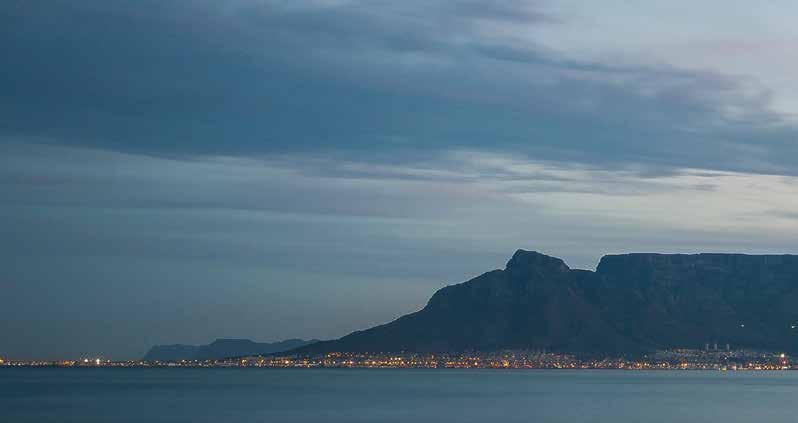
Reasons to invest: George George has several initiatives aimed at expanding its functionality, efficiency and overall attractiveness for investment. These include:
Go George This is an integrated public-transport network rolling out a fleet of buses to make safe, reliable, accessible, affordable and scheduled public transport a reality for all who work and live in George. It is a partnership between the George Municipality, the Western Cape Government and the National Department of Transport, as well as local taxi and bus operators.
George Airport expansion In January 2019, Airports Company South Africa announced a R100-million upgrade to George Airport over the next five years, including an expansion of the terminal as well as more parking and better traffic flow around the airport area. The upgrades, set to commence in 2020/2021, will increase passenger capacity from 800 000 people to 1.2-million.
Growing educational resources George is home to 51 public and private schools as well as numerous tertiary education institutes. These include the George Campus of the Nelson Mandela University, which is embarking on extensive expansions to the number of degrees being offered at this satellite campus.
Financial incentives Through its #InvestGeorge initiative, George provides financial incentives, including discounts on rates and services to approved investors, on the lease or sale of council-owned land. (In March 2018, 7.5-million hectares of incentivised, municipal-owned land was available for development.) It also offers rebates on building plan approvals (50% discount for designated developments and 25% for non-designated developments), and capital contributions phased in with payment over five years.

Future planning At a Garden Route Investment Conference held in 2018, future initiatives were also announced.
Wesgro: The Western Cape Property Report 2018/2019 research The following outlines the primary sources that have been used throughout this report.
In terms of municipal data on each region Apart from data provided by Wesgro’s own research division, information has been sourced from the Municipal Economic Review and Outlook (MERO) 2018, produced by the Western Cape Provincial Government; the South African Economic Indicators Database; Quantec EasyData; and the Economic Performance Indicators for Cape Town (EPIC) 2018 (Q3 and Q4), produced by the City of Cape Town.
Other secondary sources of data are credited in the publication footnotes.
In terms of property values for all commercial, retail and industrial properties The data accumulated and analysed in terms of properties for sale or to rent were as at what was available on the market at the time the research was conducted during the period January to April 2019, and as per the asking prices loaded onto the Property24 website by real estate agencies and commercial/industrial property brokers.
The exception to this was in terms of commercial (office) rental and vacancy rates in the areas of Bellville, the Cape Town CBD, Century City, Claremont, Central (being Pinelands and surrounds), Rondebosch/Newlands and the V&A Waterfront – all of which fall into the City of Cape Town. For these seven nodes, the most recent quarterly Office Vacancy Report produced by SAPOA was utilised. In addition to the above, for analytical purposes, use was also made of the Rode’s Report on the South African Property Market, produced quarterly by Rode & Associates in Cape Town.
In terms of residential properties All information on the market values and analytics of sold properties (i.e. market stock, age profile of buyers, price performance and activity) has been sourced from Lightstone Property.
Information on rental prices has been sourced from Property24, and the analyses of these are based on rentals being asked and stock availability as listed by real estate agencies at the time research was conducted (from January to April 2019).
Shoring up development in the midst of a construction crunch
While economic growth is fuelling expansion of construction and development sectors in parts of Asia and the Middle East, South Africa’s construction industry remains under pressure. This in turn is putting severe pressure on local property developers, who are being forced to reinvent themselves to survive
By Nicole Chamberlin

South Africa’s construction downturn not only mirrors the country’s floundering economy but has also had a detrimental impact on property and infrastructural development across the country.
According to the Construction Education and Training Authority’s joint communiqué with the Parliamentary Monitoring Group, the construction sector’s decline stems from the 2009 construction boom in South Africa (prior to the FIFA World Cup), when the sector was valued at R300- billion. Having endured ongoing contraction over the past decade, exacerbated further by contract price adjustment provision (CPAP) as a result of production cost hikes, the sector’s value has dropped to R200-billion in 2019. S
22 Nicholas Stopforth, Managing Director at Amdec Property Developments

National debt, together with a pronounced fall in government infrastructure projects, has also taken a significant toll. In the latter half of 2018, Basil Read was placed in business rescue, while construction giant Group Five experienced a similar fate in the first quarter of 2019, owing to mounting debt.
The demise of two of South Africa’s largest construction companies plunged the local property development sector into crisis, threatening to derail the completion of several multibillion-rand projects. One such project was the Amdec Group’s high-end mixed-use development – One on Whiteley at Melrose Arch – which was due to be completed and handed over to purchasers in October 2019.
“When Group Five went into business rescue, work on site ground to a halt, and it seemed highly unlikely that we’d be able to deliver the completed scheme on time,” says Nicholas Stopforth, Managing Director at Amdec Property Developments. “We realised that an immediate and rapid strategic realignment within our company was necessary if we were going to weather this storm”.
With jobs, supplier contracts, reputation and its overall investment on the line, the privately owned property group opted to vertically integrate its resources and assume direct control of the construction management process. This involved changing and broadening the scope of internal employee positions, and absorbing key Group Five personnel. In so doing, the Amdec Group was able to circumvent disaster, resuming construction at One on Whiteley within just two weeks of Group Five’s collapse.
“We took on about 35 Group Five employees who would otherwise have been jobless, and secured about 80 direct contracts with subcontractors,” continues Stopforth. “While several other developers have yet to recover from the events surrounding Group Five, we were able to turn a potentially catastrophic situation into an opportunity. Vertical restructuring has not only bolstered the proficiency of our core teams, it has also gone a long way towards futureproofing our business model.”
With the City of Cape Town’s recent approval of Harbour Arch – the Amdec Group’s R14-billion mixed-use development on the Foreshore – this restructuring came not a moment too soon. Stopforth acknowledges that sector downturns are typically cyclical, but cautions that lower volumes, additional pricing pressures and the heightened risk involved in competing for dwindling resources will see margins within the construction industry remain paper-thin, with cash flow continuing to suffer.
“The construction and property development sectors are not out of the woods yet, as each directly impacts the other,” he says. “While we’re seeing favourable take-up of residential and commercial space at both Melrose Arch and Harbour Arch, it’s vital that we remain agile in times of such market volatility and economic turmoil. Given the challenges we faced, it is gratifying to see the completed development, and meet with satisfied residents who have moved in and are enjoying the convenience of living in one of South Africa’s pre-eminent new urban precincts.”
Residential apartments at Melrose Arch have always been in strong demand, generating rental returns and capital growth that are among the highest in Johannesburg. A handful of late-release studio, one- and two-bedroom apartments remains available, priced from R2.15-million.
“As an industry, we can’t rest on our laurels and wait for the next construction boom to be presented to us,” says Stopforth. “The current lack of foreign investment calls for lateral and innovative thinking, without which South Africa’s mediumto long-term construction outlook will continue to be grim.”
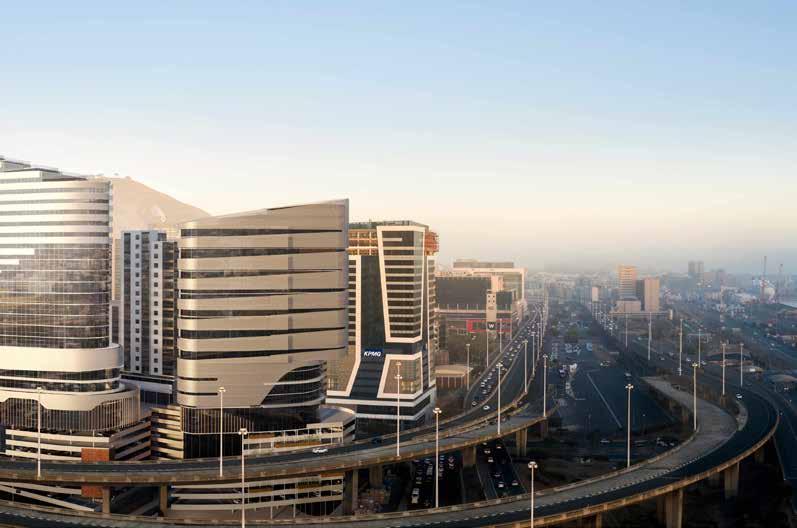
amdec.co.za
Amdec Group expands its Western Cape property portfolio
The Amdec Group, South Africa’s leading developer of new urban lifestyles, has recently acquired the multi-award-winning Sitari Country Estate outside Somerset West in the Western Cape. This forms part of the Amdec Group’s strategy to strengthen its portfolio in the region, and represents an exciting opportunity to leverage its more than three decades’ experience in the development of iconic mixed-use precincts, inclusionary housing communities, retirement villages and secure lifestyle estates
By Nicole Chamberlin
According to James Wilson, Chief Executive Officer of the Amdec Group, the Group focuses on large-scale projects within thriving metropolitan areas, so the scope and scale of Sitari Country Estate represents a compelling investment. “It provides us with a well-established lifestyle brand in an outstanding location, and adds to our prestigious portfolio of premium real A
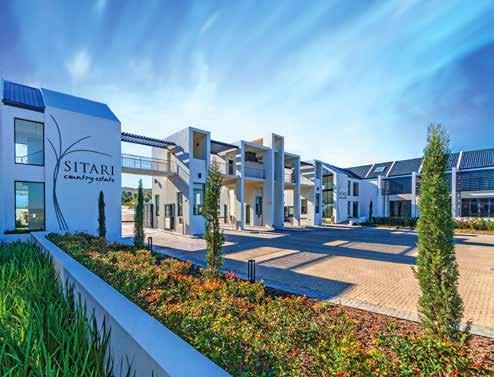
estate assets that include Melrose Arch in Johannesburg, the Yacht Club and Harbour Arch in Cape Town, Evergreen Lifestyle Retirement Villages, Val de Vie and Pearl Valley outside Paarl, and Westbrook in Port Elizabeth,” he says.
Sitari Country Estate is located within the picturesque Helderberg basin, which is currently enjoying phenomenal growth, with exciting new residential and retail initiatives that closely mirror the growth experienced in other decentralised nodes such as Menlyn in Pretoria. The area is also a highly sought-after retirement destination. The central location means residents enjoy quick travel times to Cape Town, Paarl, Stellenbosch, Somerset West and the Overberg, as well as Cape Town International Airport.
The estate spans 190 hectares and offers a range of premium and luxury apartments, village and country-style homes, as well as an Evergreen Lifestyle Retirement Village, a Curro private school, and a large neighbourhood retail centre. It also boasts orchards, vineyards, play areas and a 22- hectare wetland, interspersed with highquality contemporary rural architecture.
Sitari Country Estate was launched in 2014, and is already well established, with all primary infrastructure substantially
completed and operational. There are 3 150 residential opportunities within the estate, including a mix of freestanding erven and sectional title apartments. More than 1 700 units have been sold to date. The remaining 1 450 development opportunities will all be sold as completed houses or apartments, further expanding the estate.
Sitari Country Estate also offers a select number of offices for rent, giving residents the option of working within walking distance of their home. The estate will feature discreet security that includes CCTV cameras, a control centre on site, movement sensors, infrared beams, and biometric access control.
“This acquisition provides the Amdec Group with a variety of accommodation options in an estate that caters for a broad spectrum of the population,” says Wilson. “From young professionals and families through to empty nesters and retirees, residents will enjoy an active, convenient,
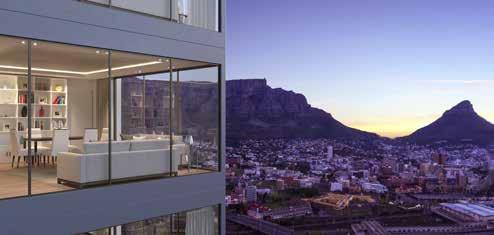
safe and secure lifestyle within a worldclass country estate. Investors can also look forward to the prospect of strong rental returns given the influx of people to the area, along with the schools, shops and other facilities on offer. The area is also home to a high concentration of hospitals and medical facilities, providing the assurance of expert medical care, irrespective of your life stage.”











